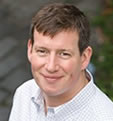Past Westminster Abbey and the Houses of Parliament, past Downing Street and the Cenotaph, and up towards Nelson's Column, tired legs squeezed out a final burst of pace.
The crowds were thick behind the barriers covered in the sponsors' banners and it was a tunnel of colour and noise as the multiple trains of riders inches off each other's wheels ran side by side up a traffic-free Whitehall.
Marshals did their odd hands-above-head YMCAesque wave of their flag to warn of obstacles and amid the cheering the adrenaline flowed and shifters were flicked as the pace increased.
It was almost certainly the closest I will ever come to the sharp end of a pro sprint stage - even if, in reality, it wasn't that close. Middle-aged lycra fantasies at their most deluded I know, but so much fun.
We closed on the sharp left at the top of Whitehall and "poof" it was gone.
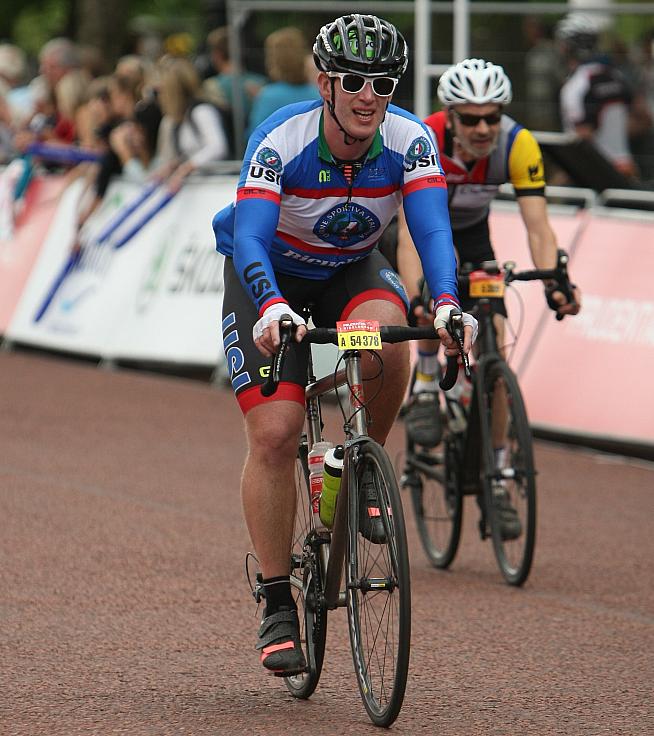
The clock above the finish line showed the 11:21. Time for selfies in front of the palace, medal collection and setting off into central London traffic to head home.
From registration expo to finish line, the Prudential RideLondon 100 is an extraordinary event in scale, scope and experience.
Read Dave Chalk's report on his ride
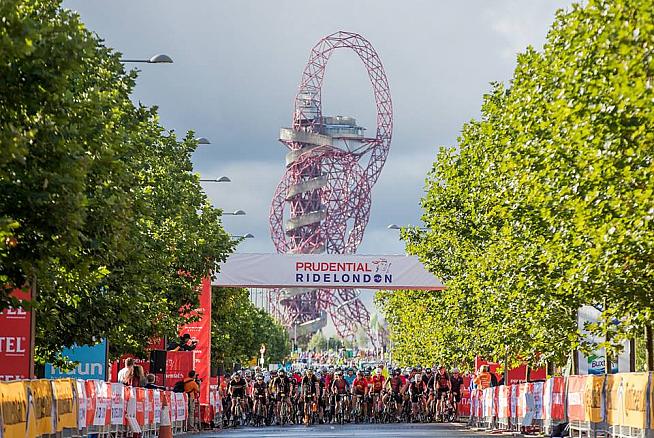
All on closed roads, catnip for cyclists.
Later the pros would follow a very similar course on the RideLondon-Surrey Classic WorldTour race, the richest one-day race in pro cycling and another part of an extended weekend of cycling in London. Hence the WorldTour-standard infrastructure in place.
The RideLondon-Surrey 100, now in its 5th year, is pointedly not a race. There's no mass start, the results do not rank riders (*see below) and the organisers can use motorbikes to enforce a speed limit on sections or, as I found out, close the course, halting all riders for a while with no explanation.
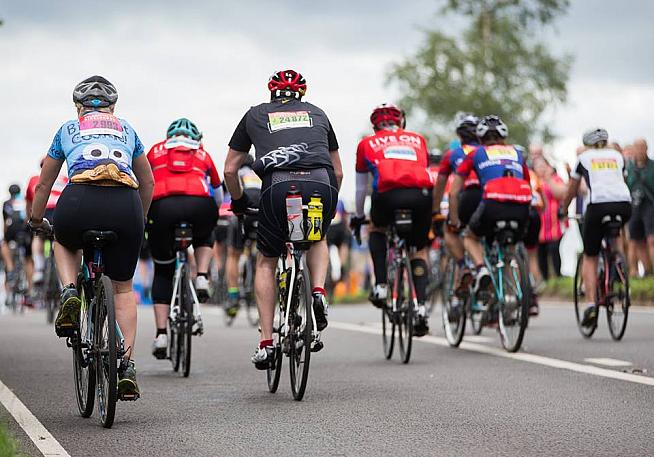
I found myself stationary in Wimbledon trying to stretch out the hamstring cramps that had started rippling under the skin in the previous 10 miles with no idea why we were blocked or how long it would last. I can only presume it was to allow a gap for people to cross the road between that point and the finish.
When released the pack brought together by the roadblock surged up the final climb on the course, the sharp little slope up to Wimbledon Village, knowing the finish was within touching distance. Large trains formed on the run alongside Wimbledon Common before the drop down to Putney Bridge. Amid the noise of freewheel hubs, wind and cheers, clear as day a small boy's "Whoa!" rang out as we charged down Putney High Street eight-abreast.
A voice behind me expressed what many of us must have been thinking: "What can possibly go wrong?"
Thankfully, I did not witness my second crash of the day and once over the bridge the twists and turns before hitting the Embankment spread us out a little for the final run along the river.
It was a magnificent feeling to fly over the tarmac past Battersea, Albert and Chelsea Bridges where so many times in the past I had sat in clogged Sunday night traffic after weekends away.
My enthusiasm got the better of me and I found myself moving up past riders and then at the front of a peloton of 50 or 60 opposite Battersea Park and on the approach to Millbank. The grumbles from my hamstrings and calves became shrieks of pain, which only increased as the appeals of my frantically flicked elbow received no response. I had to sit up and pull right over to the gutter to get off the front and then just about managed to latch on to the back of the pack for the last couple of miles and the Whitehall lead out.
The RideLondon 100 can be divided into three sections: the start to Newlands Corner, the Surrey Hills, and Box Hill to the finish.
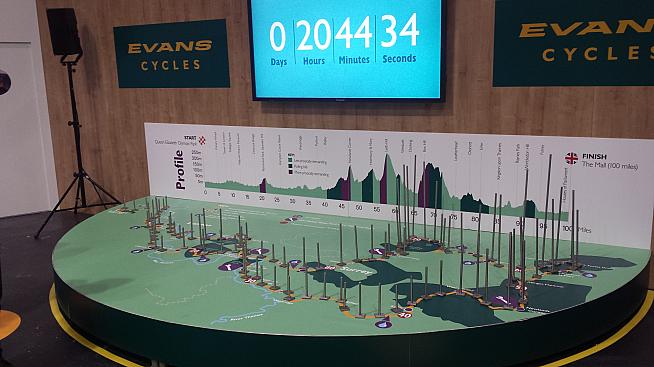
Newlands Corner hardly counts, Leith Hill is the biggest and steepest, but is only 450 feet at an average of 6% and a maximum of 12.4%, and the fame of Box Hill is puffed up beyond merit due to the Olympics and its two "Alpine" hairpins.
The three together total around 1,200 feet of climbing out of a grand total of around 5,000 feet. Factor in closed roads and the benefit of so many riders to draft off and, absent congestion issues, a quick time is definitely on the cards.
I had put five hours as my target time and was given a 6:14am start time, 29 minutes after the first wave and THREE HOURS before the last of the field of 28,000. The start was a logistical marvel and worked like clockwork.
Six colour-coded start columns separated into waves wound through the Olympic Village converging on the twin side-by-side start lines. As a wave moved off and the following one on that side moved into position, the MC queued up the music for the column on the other side and then sent it on its way.
The sky was dark grey and a few spots of rain fell as we set off on roads still damp from the soaking overnight. The dampness contributed to a relatively cautious start and the narrownesss of the start chute compared to the width of the A12 on which we were soon riding meant that the first few miles were pretty strung out. It was very different to the cavalry charges of some mass-start sportives and gran fondos.
There were clearly some people who were going to take a lot longer than five hours to cover the 100 miles and they kept to the left as fast pacelines developed as we headed towards Canary Wharf and then into the City past the Tower of London.
The jerseys on show can be a good barometer of the kind of field in which you are riding. At RideLondon it was a pretty even split between club kits (from all over the UK) and charity tops with far fewer pro and generic outfits than usual.

It was on the climb in the park that I saw one of very few moments of really poor riding. Overall, I found that the standard of riding was really quite good with, for the most part, good calling out of obstacles and slower riders keeping left. From comments on social media it is clear not everyone feels the same way and my good experience might be connected to my early start.
Coming up the hill in Richmond Park 20 miles in, a guy suddenly pulled out to pass someone going even slower than him forcing the rider 10 yards in front of me to take avoiding action. The swerver looked like a novice and as I pulled alongside him I calmly said: "Just be careful pulling out like that, you'll cause an ..." and then changed tone and started again as he pulled out his headphones. "One, you're an idiot for wearing those and, two, check before you pull out or you will cause a crash."
I heard him bleating "Oi, mate ..." as I rode away.
Twenty or so miles in farther on in Pyrford I did witness a crash.
There was no obvious cause for it. Six or seven riders were spread across the road about 40 yards ahead of me when without warning an older guy in a purple jersey veered to the right. He tried to correct, bumped into another rider and then hit the tarmac against the righthand kerb. I was off the bike and by his side within a few seconds and two young marshals appeared in a very short period. The poor guy was winded and dazed with rips to his jersey on one shoulder cuts to his leg and dramatic if not major bleeding from the corner of his mouth.
We helped him onto the pavement and the marshals quickly called for an ambulance while fixatedly asking whether he had lost consciousness, which I'm sure he hadn't although he might have been concussed. After offering my handkerchief for the bleeding I took off as he was in good hands. I heard him say "Someone just knocked into me," as I got back up to speed.
I had been employing the usual tactics of the solo rider for the first couple of hours, drafting wherever possible and constantly sizing up the riders in front to work out who was the Goldilocks wheel to suck - not too slow, not too fast, just the right pace. A male/female pair played the role nicely for a good chunk down past Weybridge.
The occasional swoop to the right to go the wrong way around a roundabout just for giggles was the icing on the closed-road cake.
There seemed to be a lot of people changing inner tubes at the side of the road in the early stages, due to the heavy rain overnight washing debris into their path I imagine.
At the top of the Newlands Corner climb, which gets up to 7 or 8% for around half a mile, I stopped at the huge feed stop or "Hub", refilled my bottles, polished off my sandwiches, grabbed a gel and made a pit stop.
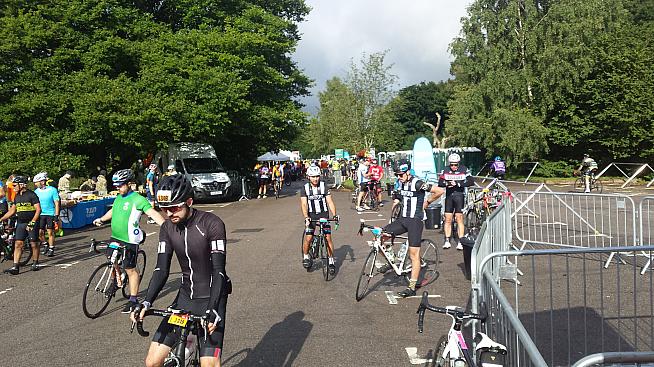
Leith Hill was next after the wide open Newlands descent. I had never ridden it.
The approach though Holmbury St Mary is on smaller roads and lovely country. On the climb itself the road is smaller again and the lack of room meant you had to keep your wits about you to pass the slower riders keeping to the left while leaving as much room as possible for the climbers flying up on the right. I can absolutely see how with not many more riders it could get very difficult. I saw very few walkers and if you added people stopping and getting off their bikes traffic jams would result.
Dorking flashed by on the run to Box Hill, which I took steadily.

I've done enough sportives to know how much and what I need to take in over a hundred miles or so to keep me fueled and avoid stomach issues. For me, a heavy ration of homemade peanut butter and jam sandwiches before the start and in the early stages transitioning to gels and watered down Coke/Pepsi later on does the trick.
I was so happy to spot the full-fat Pepsi on the Box Hill table that I told them to keep the change!
With my fuel squared away the home stretch beckoned.
It's a lovely feeling surfing a stream of slower riders, hunting down the next person on the road, for a moment drafting behind them and then searching ahead for your next target as you pass them. Between Box Hill and the edge of London I did quite a bit of it before latching on to a fast group.
Dreams of being pulled at warp speed all the way to the line were dashed by a jolting drain cover that made me drop my train just before Gigg's Hill Green. It was probably only 60 seconds to slow to a halt, remount the chain and get back on my way, but the group was, of course, long gone and it was back to surfing until the approach to Kingston when faster wheels to suck appeared in abundance. Prominent among them were four riders in the green of Bolsover & District Cycling Club who dragged along quite a few of us between there and the finish.
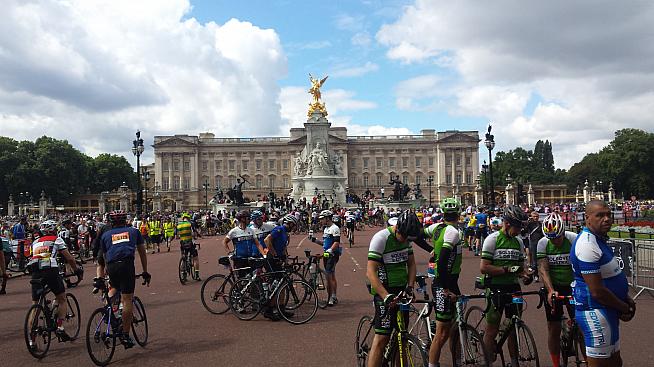
After a moment or two of confusion over the cyclists coming the other way - "Are we doing a 180? Surely not! Oh, are they, yes, they must be late starters still heading out ..." - it was on to Wimbledon and the enforced halt.
For me, riding on closed roads sits at the top of the cycling totem poll. If you love running at high speed in a pack with riders all around and the buzz that comes with that then RideLondon is a dream. Riding on closed roads through one of the world's great cities is an unforgettable experience and, for me, easily outweighs some of the irritations caused by the ride/not race set up.
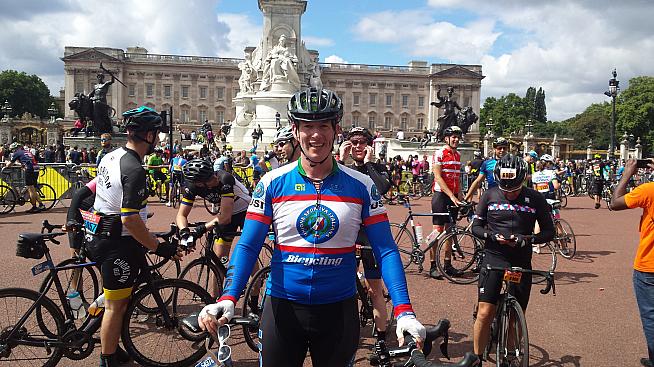
Stick your name in (try for an early start time). RideLondon is too good to miss.
Timing Postscript
While there is no official ranking of riders, "matthewgwelsh" modestly mentioned in the comments section of a Guardian piece on the event that he had knocked up something out of a spreadsheet and some html he had lying around. It can be found here.
It lists me at 2,463rd in 5:05:15, which is good enough for me.
I don't have any gadgets on my bars at the moment so reconstruction from Strava segment times is the best I can do to estimate the time I lost due to stopping to help at the crash and the roadblock in Wimbledon. (I understand that this is almost certainly of interest only to me, close blood relatives and a couple of friends.)
It looks like the crash assistance brought down my average speed from 22-24 to 13.4 mph in the relevant segment costing me around two-and-a-half minutes. And just under the same again in Wimbledon. It would have been very close to five hours.
0 Comments

